Celebrating the Ambra PC – the computer that so nearly broke the mould
 Friday, December 5, 2014 at 10:16PM
Friday, December 5, 2014 at 10:16PM  Alan W
Alan W Take Your Mind For A Run
I updated this in May, 2022.
I cut my first computer teeth on an Amstrad PCW9512, a machine that in the late 1980s introduced me to the world of word-processing, cut and paste, pagination, file management and printing thanks to the marvellous Locoscript Software.
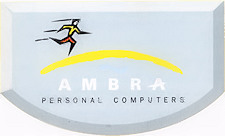 In 1992 along came Ambra, an IBM-compatible PC made by a subsidiary of IBM themselves, called ICPI (Individual Computer Products Ltd.). That IBM marketed its own clone was something of a conundrum, as the Ambra was pitching itself against the IBM PS/VP (Personal System ValuePoint) entry-level PC and others, where price was everything. Maybe the close competition and rivalry would keep each on their toes. Or maybe it was just a marketing exercise by IBM, out to prove a point or possibly to learn more about how to cut costs.
In 1992 along came Ambra, an IBM-compatible PC made by a subsidiary of IBM themselves, called ICPI (Individual Computer Products Ltd.). That IBM marketed its own clone was something of a conundrum, as the Ambra was pitching itself against the IBM PS/VP (Personal System ValuePoint) entry-level PC and others, where price was everything. Maybe the close competition and rivalry would keep each on their toes. Or maybe it was just a marketing exercise by IBM, out to prove a point or possibly to learn more about how to cut costs.
There are some interesting comments from Ambra-insiders in the comments section below. Note I have mainly focussed on their UK/ European operations rather than USA/ Canada.
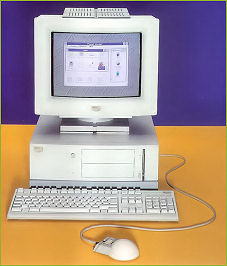 The original Ambra Hurdla (1992) with stylish monitor and fascia mouldingsAmbras were smart and sharply priced and unlike every other PC on the market they had unique German styling that made them an attractive-looking machine. The first batch of Ambras was built by Wearnes, but the second tranche would be assembled in Scotland by IBM (Greenock) and I just HAD to buy one!
The original Ambra Hurdla (1992) with stylish monitor and fascia mouldingsAmbras were smart and sharply priced and unlike every other PC on the market they had unique German styling that made them an attractive-looking machine. The first batch of Ambras was built by Wearnes, but the second tranche would be assembled in Scotland by IBM (Greenock) and I just HAD to buy one!
Ambra had three machines, the Sprinta slimline desktop, the Hurdla full size desktop PC and the Treka notebook.They started life with DOS 5.x and Windows 3.1.
My Ambra Hurdla had 4MB of RAM, a 100MB disk, a floppy drive, no less than six ISA expansion slots and room for a 487SX Intel Overdrive maths co-processor. You could choose 386 or 486 processors. It was a fast machine and trounced the opposition in some magazine reviews; no-one ever called it slow or ugly. Practical PC Magazine in its March 1993 review called it "a 25MHz 486SX that acts like a 33, but a whole lot cheaper. Fabulous!" while PC Direct said "[the Hurdla 486's] unusual styling hides a neatly built, well-specified and fast machine."
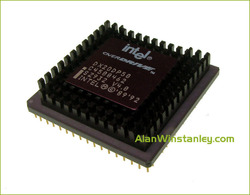 Intel Overdrive 487 Maths co-processor (1993) - seems it was a replacement CPU with floating point maths enabledI upgraded my Hurdla 486SX to DOS 6.22 in due course, also adding the Overdrive processor (which it seems was a whole CPU with the extra floating point logic, that disables the onboard CPU). I asked a shop to add a second hard disk until my confidence and knowledge grew on a need-to-know basis. It also had splendid printed manuals (which I still have - see below for the Ambra Hurdla Quickstart manual). I recall that adding a sound card and parallel card to add a second printer (no USB then) was a pig of a job, all those IRQs to juggle with.
Intel Overdrive 487 Maths co-processor (1993) - seems it was a replacement CPU with floating point maths enabledI upgraded my Hurdla 486SX to DOS 6.22 in due course, also adding the Overdrive processor (which it seems was a whole CPU with the extra floating point logic, that disables the onboard CPU). I asked a shop to add a second hard disk until my confidence and knowledge grew on a need-to-know basis. It also had splendid printed manuals (which I still have - see below for the Ambra Hurdla Quickstart manual). I recall that adding a sound card and parallel card to add a second printer (no USB then) was a pig of a job, all those IRQs to juggle with.
It would be some time before I ventured out onto the web (as far as there was one), installing a 14.4k Trust ISA internal modem, and battling against the mysteries of the Trumpet Winsock, Compu$erve, Pegasus Mail, Demon Internet and KA9Q. But it happily drove an HP LaserJet IIIP and HP Deskjet when inkjet printers became more sensible. A Trust 3-pass parallel scanner (remember those?) was really terrible and was returned. Overall, the expandable Ambra took in its stride everything that I threw at it over many years and I learned an awful lot during that decade. As its capacity started to wane, I would then network it to a (very expensive) 166MHz Dell PC.
The handsome Ambra product range also benefited from some stylish marketing to some degree and everything bore Ambra’s corporate branding. The Ambra’s colour scheme was battleship grey and off-white. Its 14” SVGA monitor had a large smooth futuristic off-white bezel and was crowned by a weird grey plastic platform stuck on top. It pivoted on a cross-shaped moulding fitted onto the base unit. The stylish base unit was well made, having a smooth curved grey front. Problem was, if you wanted to add a (single or twin speed) CDROM drive, you were stuck with a standard beige drive stuffed into the curvaceous fascia, as that’s all there was.
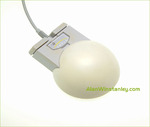 Ambra PS2 mouse (1992)Probably its most controversial feature was the Ambra PS2 mouse, a half-round dome that you didn’t so much click downwards as click the buttons towards you, as if curling your fingers up. I didn’t mind it but others were affronted by the sheer weirdness, designed by designers not users, and many quickly chose an ordinary Logitech mouse instead. It was redesigned in due course.
Ambra PS2 mouse (1992)Probably its most controversial feature was the Ambra PS2 mouse, a half-round dome that you didn’t so much click downwards as click the buttons towards you, as if curling your fingers up. I didn’t mind it but others were affronted by the sheer weirdness, designed by designers not users, and many quickly chose an ordinary Logitech mouse instead. It was redesigned in due course.
Ambra also included their own slim keyboard and it wasn’t a bad thing. Later, Ambra would supply a rebadged IBM clacky type. Software bundled with my PC included the fabulous Lotus Ami Pro, great word processing software that launched much of my work in the 1990’s.
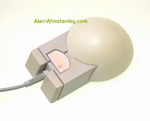 According to one visitor who posted comments (below), Ambra then launched a cheaper line called "Maverick" but it wasn't very popular. Scouting around online, I found images of a flat-fronted Ambra desktop and IBM M-series keyboards badged as Ambra (see links, below). As it happens, I also have a December 1993 Ambra brochure called 'Direct to your DESK' which shows... a relatively stylish but flat-fronted slimline Ambra sprinta II desktop and an anonymous-looking mini tower called the Ambra hurdla mT. They both include the striking Ambra 14" monitor that we'd seen previously. These were Intel 486 machines, SX/25, DX/33 or DX2/66. The full-size hurdla desktop (like the one I'd bought) was dropped. Remember that VAT was an extra 17.5% on prices shown.
According to one visitor who posted comments (below), Ambra then launched a cheaper line called "Maverick" but it wasn't very popular. Scouting around online, I found images of a flat-fronted Ambra desktop and IBM M-series keyboards badged as Ambra (see links, below). As it happens, I also have a December 1993 Ambra brochure called 'Direct to your DESK' which shows... a relatively stylish but flat-fronted slimline Ambra sprinta II desktop and an anonymous-looking mini tower called the Ambra hurdla mT. They both include the striking Ambra 14" monitor that we'd seen previously. These were Intel 486 machines, SX/25, DX/33 or DX2/66. The full-size hurdla desktop (like the one I'd bought) was dropped. Remember that VAT was an extra 17.5% on prices shown.
Ambra brochure December 1993 'Direct to your DESK' (PDF, 3.2M)
Judging by this brochure, the marketing was looking a bit cheap and frayed at the edges by then. The lovely 'Take your mind for a run' and the ‘less is more’ arty consumer style was waning, and this brochure seemed to be targetting office users more than home users. It was maybe a sign of desperation or perhaps the writing was already on the wall about Ambra's viability.
As an aside, Ambra's UK address was Europa House, Church Street, Isleworth. I couldn't find that on Google Maps until I came across this location. Going back on the Google timeline, Home House (today) used to be Europa House. Must have been a nice place to work, and it's always sad when 'For Sale/ Rent' signs go up. It seems it was taken over by London creative agency M-is as their new HQ, which was opened in 2014 by the London mayor, a certain Boris Johnson. Notice they spruced it up and redecorated the ugly tubes with perforated steel.
Overall I enjoyed many years ownership of my first Ambra PC before passing it over to my Mum to teach her basic word processing: which she did, writing her life's diary using the same Lotus Ami Pro. I still cherish her life's diary to this day. It was a sad day when my Ambra Hurdla finally went to the rubbish tip, but the Intel Pentium, Windows 95 and Dell PCs came along and I was hungry for more speed by then.
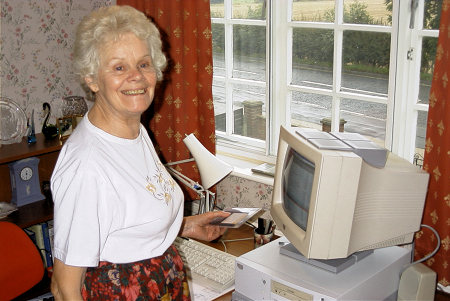
 (London) Daily Telegraph, 1994It was a crying shame when IBM suddenly axed Ambra, the stylish and powerful IBM clone that probably proved to be a thorn in the side for IBM.
(London) Daily Telegraph, 1994It was a crying shame when IBM suddenly axed Ambra, the stylish and powerful IBM clone that probably proved to be a thorn in the side for IBM.
Legacy Ambra literature (PDFs) and Ambra links
Ambra Sprinta Mk. I slimline desktop, 1992
Ambra Hurdla Mk. I full size desktop, 1992
Ambra brochure December 1993 'Direct to your DESK' (PDF, 3.2M), showing the Ambra Sprinta II 486 and Ambra Hurdla mT mini tower which replaced the full size Hurdla desktop. Note the redesigned mouse.
IBM ends Ambra PC range in Europe (The Independent Newspaper, 1994)
Ambra advert on YouTube, wonder where it was filmed? In England, judging by the housing or Germany judging by the Puma brand? - See Take Your Mind for a Run
French language (Canadian?) 1992 advert for Ambra on YouTube
Uncle Awesome on YouTube - unboxing an old Ambra Sprinta 486 (Feb. 2020)
A possible sighting of a cheaper version Ambra called the Maverick - a simpler, square front panel using the power button as the ICPI Ambra sprinta and hurdla. (Later: it is almost certainly an Ambra sprinta II.)
Wikipedia on the IBM Model M Keyboard. An Ambra Model M(?) keyboard - seems like a US / Canadian brand for its cheaper IBM clone. An Ambra Model M keyboard on Imgur - a rebadged standard IBM Model M keyboard. A clean Ambra Model M keyboard on Geekhack, was made by Lexmark. And another one (ICPI, made in UK) on deskauthority.
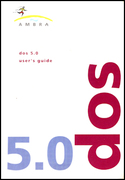 A full DOS 5 driver's manual was also included
A full DOS 5 driver's manual was also included
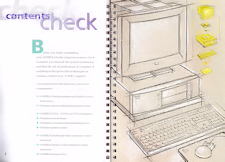 Ambra Hurdla Quickstart guideAmbra Hurdla Quickstart guide (circa 1992), a wirebound setup booklet for new users with stylish graphics (PDF)
Ambra Hurdla Quickstart guideAmbra Hurdla Quickstart guide (circa 1992), a wirebound setup booklet for new users with stylish graphics (PDF)

 Alan W
Alan W
I had a nice email from the Ambra's designer, who said he designed it for IBM while working for frog design in Altensteig, spending a lot of time in Taiwan producing it. The Ambra was a great project, he says, and he met a lot of enthusiastic people.

Reader Comments (25)
Damn, that was my first computer. I still remember its specs, from when I got it to when I upgraded it. It was back in 2001 but as a poor teen (I was 13), it was the best christmas gift ever.
If you're curious:
80486 DX2 66mhz, 21mb ram, 250mb hard disk, floppy disk drive.
I upgraded it with two 1gb scsi hard disks, a yamaha opl3 sound card and a 1x cd-rom drive by the time I got something better.
It's gonna sound silly to you but ever since I've been trying to find back one of these guys, but they seem really rare and I guess I'll just never have another unless a gigantic stroke of luck happens.
Still, thanks for the memories c:
I have only seen one Ambra on ebay, that was last year and it was a sorry state in someone's garage. The ABS housings tended to yellow and fade, especially the monitor, but I too was sad to see mine go. Glad you liked the blog.
Yeah... when I got mine, its colors weren't yet tarnished. I didn't have the screen or mouse (the screen died out and the mouse had been replaced for what I assume are obvious reasons) but I had this spiffy screen with a button on its side that simulated CGA colour palettes. The good times I had with that computer <3
but then when I was given another computer, I was told to throw this one out because they didn't want me to keep two computers in the same room. It was when I noticed how much it yellowed in the sun.
ABS plastic tends to go yellow after a few years, not even in direct sun but near a window is enough to make it go mouldy-looking. My expensive Microtex 8700 flatbed scanner and Brother printer have all done the same. More noticeable on the Ambra monitor as it was white.
Retro computer restorers play around with hydrogen peroxide and UV lamps to reverse the yellowing, with some success. Have a look for RetroBright.
You say Ambra computers were built by Wearnes and then by IBM Greenock, but in 1990-1993 I was working for IBM International Distribution Center in Holland, and in 1992 and 1993 we were actually building them on behalf of ICPI for all of Europe. The hardware came from Asia and we assembled the configurations as ordered by the national computer store chains or the individual customers*, preloaded the latest software versions and shipped them off.
*) We were a sort of a Dell as well: in selected countries, customers could get their Ambra computer shipped to their doorstep, straight from our distribution center. The boxes for a full desktop set were huge, while the Tekla notebooks came in a very cute cardboard 'suitcase'.
I've just found the receipt for my Ambra Sprinta II, from Wilding Office Equipment in 1993 - can you believe £1,056? That's the penalty for wanting to be in early, I suppose. The machine itself went years ago, but I'm still using the Ambra mouse-mat!
Great to read something about these machines, so many years on. My first PC (at 8 years old) was an Ambra Hurdla 386, 25MHz with an 80 MB HDD. No sound card. If I recall correctly, ours came bundled with Microsoft Works, Lemmings, and an Ambra-branded sliding puzzle game.
I have an Ambra that I got in 1992. We use it to play "How Things Work in Busy Town" and to play with WordPerfect 5.0. It has never been upgraded so it is all original.
Would anyone be interested in it?
You were kidding with this article, right? I was one of the first dozen Ambra employees. I did the monthly sales and marketing spreadsheets. The Ambra machine was pure junk. They were intentionally designed to be a low-end machine for the low-end of the PC market. All internal components were the latest "bargain of the day" off the weekly boat from China. That's why no two runs of machines consisted of the same components. Failure rate after sale was phenomenal. Many refused to boot straight out of the box. But shoddy components wasn't the reason Ambra closed its doors after only a year. It was because management spent their days jockeying for power rather than trying to get a startup off the ground. I can't emphasize this enough. Week after week of all-day meetings behind closed doors and nothing accomplished but bloodletting. The reason being that the management team consisted solely of IBM middle managers who saw Ambra as their one shot at the lofty heights of corporate glory. Within four months most of the original staffers had quit due to the intensely acrimonious work environment. I stuck it out the entire year. Then took a month long vacation to recover fro it.
Sorry to hear the dismal picture painted behind the scenes, but my view was from the UK/ Europe perspective and Ambra always won hands down in reviews (speed, spec, value for money) and was well liked over here. They lost their way over time and the rest is history. My machine always performed well, the only thing going wrong was the FDD.
I can vouch for the Hurdla being a good computer. It was low-end and by the time I got mine (in 2001, it was my first computer and a Christmas gift) it was severely outdated but I got to play lots of games on it, even some quake though I did realize the cpu wouldn't cut it.
It was a perfectly fine little machine and I never once had any problems with it.
My first real PC! After the C64 and the Amiga I could buy one of these with a project from my employer. Back in those days the government stimulated the sales of PC's so you could buy one and pay it back from your salary and get a huge tax cut. I opted for the 486Dx33, it was an awesome machine. It had a Cirrus Logic 512Kb videochip and ran Wing Commander like there was no tomorrow. I equipped it with a Pro Audio Spectrum soundcard, which wasn't very smart, because the Soundblaster was the standard, but I didn't know that back then. Still, it supported quite a few games.
Not only I bought the PC but most of the people who worked at the same employer did as well and since I was the computer guy I also had a nice thing on the side helping other people configure their computers, building in soundcards, etcetera. Not one of them broke down, so I find it very hard to believe that they were "junk". After a while I could sell it for a good price and bought a 486DX50 in a bigtower. Those were the days.
I was in at the beginning, the launch and the distribution for both the European and USA - for AMBRA. I was asked by IBM to Project Manage the outsourcing of all the bill of materials (except the CPU and Monitor). I worked with Frog Design and other suppliers and created the first PC Language Pack for the European Market. We drove the project from design to delivery. We then launched it in the USA.
The project was a major breakthrough that led to IBM discovering that their PC company cost base was indeed way too high, leading them to outsource more and more components and eventually their entire PC business. This - combined with digitisation and increasing competition from Asia - led to IBM closing their PC Operations and eventually selling their technology to Lenovo.
The challenges were vast - the timeline to market was one third of what IBM were achieving with their own brands at the time, the language pack allowed us to serve multi-language markets at the same time - for the first time. IBM proved to be fabulous partners, skilled, knowledgable and honest to a fault.
It was perhaps the most important period in the history personal computing, it was the beginning of the end of hardware and the realisation that software would in future be king. IBM's appetite for winning the PC race (that they had led from the beginning) was rendered obsolete - such is progress - AMBRA showed IBM that they were paying too much for their components, software and distribution. AMBRA never had the full support of the IBM PC company, that was never it's purpose.
My parents bought me a Hurdla as a Christmas present from BYTE computers in 1993. It had a 486SX/25 CPU, 4MB RAM and a Seagate 100MB IDE drive and the updated mouse. I remember it came with an app that was supposed to produce the floppy disk images for Windows 3.1 and MS-DOS 6; not fully understanding the purpose of this when I was 9 I deleted the images before realising that I could never reinstall the OS or Windows. I remember AMBRA kindly sending the 4 + 6 disks for each software, and later a video driver for the SVGA card in the post when we wrote them a letter asking them for copies...
We updated it with (I think) a non-Intel DX2/66, another 4MB RAM, sound card, CDROM and a WD 850MB drive in later years. It lasted us all the way up until 1998 when I tried to play Total Annihilation on Win95. Suffice to say it wasn't up to the task and there was little more we could do with it, and got replaced with some brutal beige monstrosity we built. We kept the monitor, keyboard and mouse as they were good bits of kit for the time.
The thing that lasted the longest was actually the fantastic grey mousemat that I finally parted ways with in 2014. It was fabric topped, not rigid at all and stuck to the desk like glue.
I have an Ambra Hurdla 486 in storage. Still has the original software installed on it although I have also got the floppy disks with the software on just in case. The PC is stored in the fully original packaging and has all manuals etc...
The CMOS battery is now long dead so the PC requires the hard disk info to be manually entered in the BIOS before it will boot although this could be sorted by someone willing to solder onto the motherboard a new (barrel type) battery. The keyboard for some reason does not work so I have used a third party PS2 keyboard when I have needed to in the past.
Monitor and PC are in extremely good condition although the screen has suffered from the yellowing of time which can be fixed using bicarbonate of soda apparently...
Don't want to sell it really as I have so many fond memories. although I could be tempted if it were to make me an insanely rich man. This PC may not be as old as some of the vintage kit out there but the story speaks for itself...
[Email address supplied]
I was thirteen when Ambra launched in the UK, and I saved for over a year doing any part-time work I could get to be able to buy the first Ambra Sprinta Plus 386SX with just 2MB RAM and a 40MB disk drive. If I recall it had four SIMM bays which could handle 4 x 4MB SIMMs max, you could add a 387 Math Co-Processor, and had 3 ISA expansion bays which a quickly filled with a Sound Blaster Card, and a game card. I had always intended to get a fax modem for it but that never happened.The first generation had a central 5.25 expansion bay for a disk drive or CD-ROM but unusually the plate was moulded and not removable so I had to cut it out with a stanley knife to install the CD-ROM. The mouse was always contentious, but I liked it, and the keyboard was really nice. The following generations replaced them with re-badged IBM ps/2 peripherals. One real pain was the license non-disclosure agreement for the software. The floppy disks were not included. Twice I rang into the call centre to get the floppies posted to me. It had IBM DOS 5.0 pre-loaded, Windows 3.1, Lemmings, Microsoft Works licensed to "A valued customer of Ambra Personal Computers", and an Ambra Tutorial program (DOS Based) with a note from "Alan J Willsher, General Manager". User Manuals were provided for all the software and were Ambra Branded, as well a hand-drawn installation guide. The BIOS was Phoenix BIOS, and the hardware was stamped on the rear as "ICPI Ltd" which stood for Individual Computer Products International. I was really disappointed when they closed down, I think they just needed to be a bit more clever with the marketing and offers and it could easily have been more successful. Perhaps even a subtle reference to IBM would have helped in the marketing to secure its place as at the very least a home computer. They must have spent a lot of time on the actual software pre-load as there was a selection of Ambra Wallpapers as well as the Ambra intro program. In later models if I recall they released a "Disk Builder" application so you could easily generate your own install disks for the pre-loaded software. If anybody has still got any an original HDD I'd quite like to clone it and create a wikipedia page on it for historical reference. Good site Alan, thanks!
By the way... ICPI also created another PC Line called "Maverick" - it wasn't anywhere near as popular as the Ambra.
Awesome blog post here and i believe it's the most complete (with comments, which are a gold mine) source of information on Ambra computers on the web!
One fateful day in 1993 my dad took me out to buy a PC. It was pretty forward thinking of him now I think about it, considering most households didn't invest until the Pentium came along with its silly jingle and copywriteable name. I was originally under the impression that we had bought it from Ryman's, but I just saw someone mention Wilding's in the comments and it suddenly rang a bell (I think Ryman's bought them out soon after).
We came away from the store with the absolute bottom of the line: a Sprinta with 386SX running at 25Mhz, with 2MB RAM, 40MB hard drive and monitor with 640x480 max resolution. We also got a tiny Epson inkjet printer and a bunch of floppies to backup the file system.
I learned so much from using that system and fixing computers ended up being my profession. I now repair and restore vintage computers for fun, such is my obsession with that era.
That reminds me of the time a mate of mine purchased his first PC from one of the many specialised retailers that appeared on the high street (Encom, I think they were called - although Escom also existed). It kept on crashing inexplicably even though it was new and i worked out it was overheating - the cheeky feckers had sold him a 486DX/100 but overclocked it to 120MHz! His parents were fuming and drove straight down there with me (i must have been 14) to reveal my findings. The staff were very quick to provide a replacement.
Here's a blog post I wrote about the games i would have played on this PC. So many great memories.
The cool thing is that I used the Ambra mouse driver om all my dos machines. It used a few K less of memory!
I have an Ambra 286 complete, never used, new in original box and a Lexmark printer that came with it also unused and in the original box.
[Canada - AW]
I've got a Sprinta mk 1. Slightly upgraded to 4MB (had 2MB when I got it) and a larger hard drive. Feels quite quick when compared to other 386 boxes I have encountered. Sadly it almost died of Varta cancer a while back (3 vias dead) and I haven't had a chance to do the repairs yet.
Only real annoyance is that it doesn't play nice with DOS 6.22. Try a warm boot and it just beeps and locks up. BIOS update needed I guess (assuming they ever issued any).
Would be nice if anyone out there has the motherboard manual, there are a lot of jumpers on the board and none of them are labelled so any help in working out what jumper does what would be appreciated.
I had an ambra 486 dx 33, 4 mbram. I spent part of my adolescense triying to find a compatible 4mb aditional to the board. Expensive ones and lot of them not totally conpatible. I think due quality of ambra specs.
I bought an Ambra Hurdla the other day for a good price. Cleaned the case and brightened the bezel of the 5.25“ FDD as well as the power switch button.
The pc hasn‘t been used much because it’s in very good condition. The barrel battery has only just started to leak but there was no corrosion damage at all!
There‘s a 107MB harddrive, 3.5 and 5.25 FDDs, no cd rom drive, all 8 RAM banks are populated, 256kB of cache and a 486DX50 cpu.
According to the jumper settings, I haven’t tested the machine yet.
The onboard graphics chip is a WD90C31.
Ah like many the Ambra was my first proper PC - I reckon I was 13 or 14. It was a 486DX50 from PC World (UK), to which I added a low end sound blaster compatible sound card, and later a CD-ROM (DOTT being the first game). The FDD died, and hack sawed the top drive bay plate and put a new one on top of the CD drive.
Thanks for the memories!
Enjoying all the stories here over the years, especially the behind-the-scenes insight. Looks like this comment section has become the de facto forum for (ex) Ambra users!
Just came back to say there's an Ambra Sprinta 486 on display at the University of Helsinki, as used by Linux creator Linus Torvalds back in the day. You can find pics on reddit.